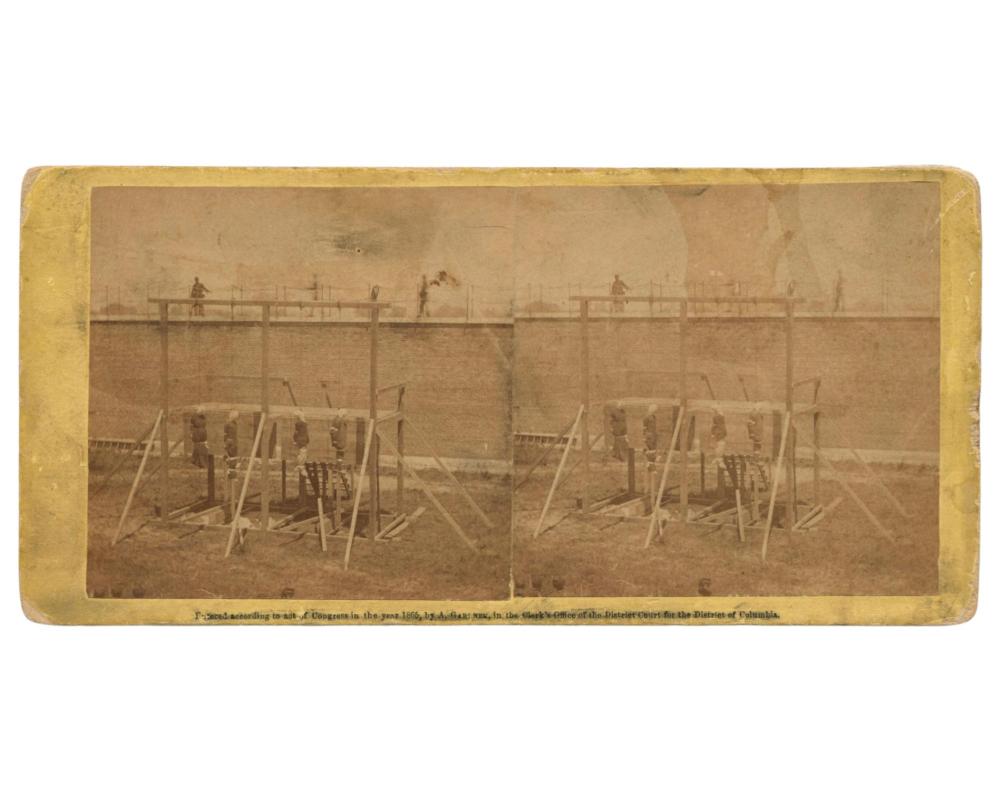
The Hanging of the Lincoln Conspirators A Newly Surfaced Museum-Quality Stereoview by Alexander Gardner
Share
Rarely in American history has a single photograph so powerfully captured the gravity of a moment—and so shaped our understanding of it—as this stereoview by famed Civil War photographer Alexander Gardner. Taken on July 7, 1865, at the Old Arsenal Penitentiary in Washington, D.C., this extraordinary image depicts the hanging of four conspirators involved in the assassination of President Abraham Lincoln: Mary Surratt, Lewis Powell (alias Lewis Payne), David Herold, and George Atzerodt. Its rediscovery and offering as a newly surfaced, museum-quality piece is a testament to both the enduring fascination with Lincoln’s assassination and Gardner’s pivotal role in documenting the American Civil War era.

A Chilling Moment in History
In the waning days of the Civil War, President Lincoln was shot and killed at Ford’s Theatre on April 14, 1865, by the Confederate sympathizer John Wilkes Booth. Although Booth was soon tracked down and killed, several of his co-conspirators were rounded up, tried by a military tribunal, and condemned to death. Their execution—pictured here—was carried out on July 7, 1865. This event was historic not only for its national impact but also because it marked the first time a woman, Mary Surratt, was executed by the federal government. Gardner’s photograph, often referred to as Execution of the Conspirators: The Suspension, captures the scene at the precise moment after the trapdoors were released, showing the four conspirators hanging from the gallows. Surrounding them are military guards, officials, and spectators standing along the prison wall, solemn witnesses to what was arguably the most consequential federal execution of the 19th century.

Alexander Gardner’s Masterful Eye
Alexander Gardner (1821–1882) was among the most influential photographers of the Civil War period, renowned for his battlefield images and poignant portraits of key historical figures, including President Lincoln. His artistry and technical skill are unmistakable in this stereoview, part of his series Photographic Incidents of the War. The reverse of this particular stereoview carries Gardner’s studio label (No. 983) and the title Execution of the Conspirators: THE SUSPENSION, offering a window into how these images were originally cataloged and sold.

Stereoviews were a popular format in the mid-to-late 19th century, designed to be viewed with a stereoscope, which created an illusion of depth. That 3D-like effect must have added yet another layer of intensity and immediacy for contemporary viewers, confronting them with the stark reality of the conspirators’ fate.
Exceedingly Rare & Highly Sought After
Photographs of the execution of the Lincoln conspirators are incredibly scarce. They do appear on the auction market once in a great while, but their value tends to reflect both their rarity and immense historical significance. In 2012, an albumen print of this same image realized nearly $14,000 at auction. Given the impact of Lincoln’s assassination on the national psyche and the singular nature of Gardner’s documentation, this stereoview has long been considered a “holy grail” among Civil War and photographic collectors alike.
Historical Significance and Controversy
The Lincoln assassination conspirators’ trial and subsequent executions remain controversial to this day. Advocates for Mary Surratt argued that her involvement in the conspiracy was never conclusively proven, while others maintained that she played a key role in Booth’s plot. The speed of the executions, overseen by a military tribunal rather than a civilian court, raised questions about due process—even at the time.
Nevertheless, Gardner’s images serve as a stark reminder of the intense emotions and desire for swift justice that followed Lincoln’s assassination. They also illustrate how photography—a relatively new medium during the Civil War—dramatically shaped public perception. By freezing moments of war, death, and aftermath in lasting detail, Gardner’s work altered how Americans came to terms with both the conflict and its tragedies.
A Testament to a Pivotal Era
For historians, collectors, and anyone fascinated by the Civil War era, this stereoview could be the centerpiece of any assassination related collection and even after surfacing more than 150 years later, the image still resonates with the same mix of shock, gravity, and historical importance.
